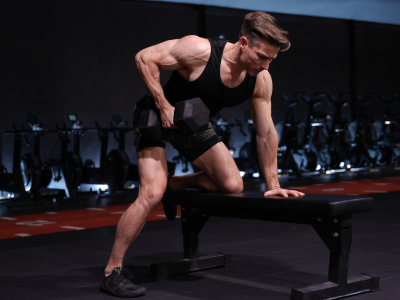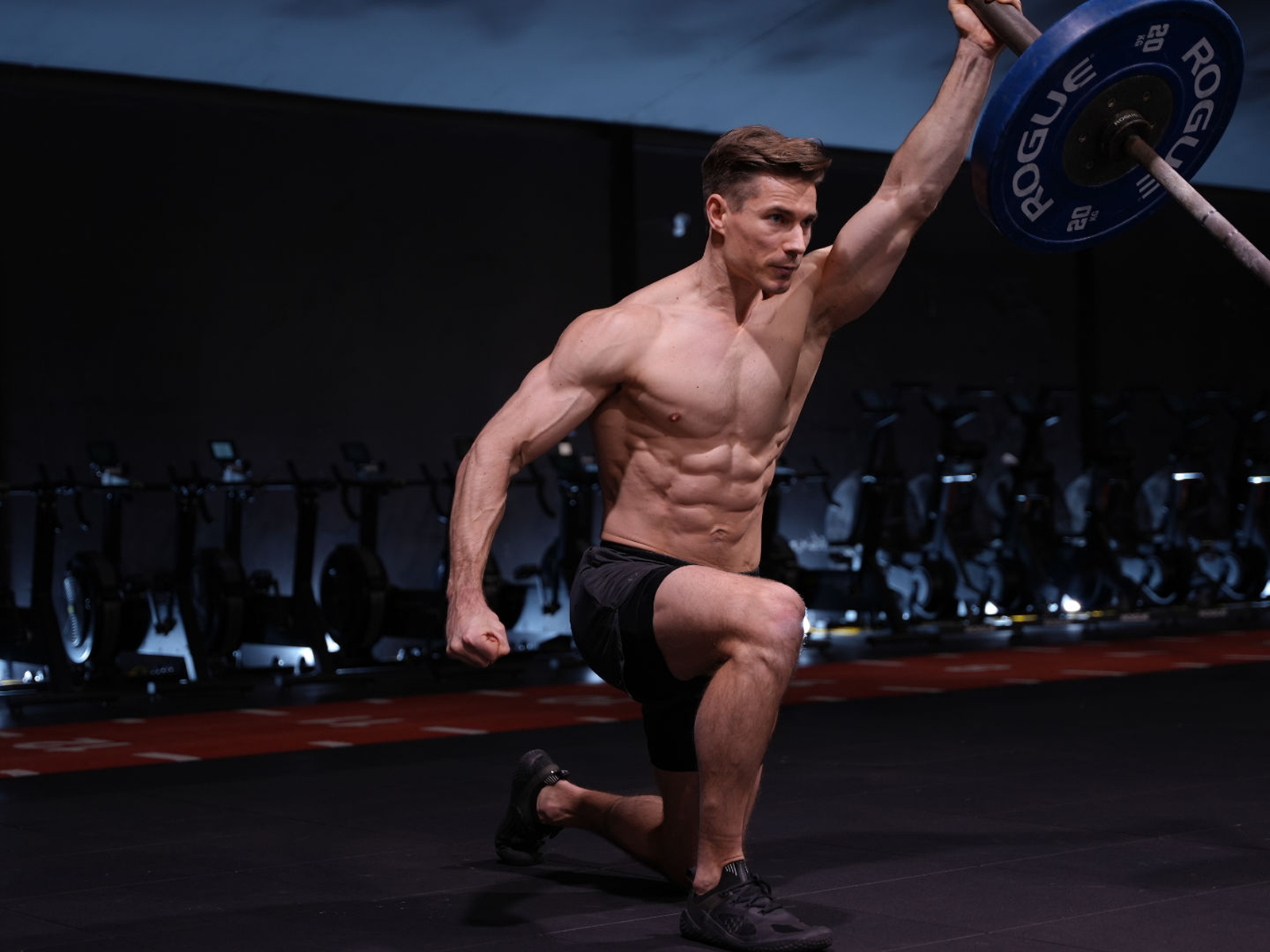Warming up for weights can be the defining factor between crushing your workout and half assing it.
Seriously.
Walk straight form your office to the squat rack and you can be sure of the following:
- Stiff hips that refuse to descend even close to parallel.
- Poor movement quality and coordination.
- Weights to feel heavy as shit.
On the other hand, if you were to spend just 10 minutes oiling up the joints and activating key muscles, those squats would be a different story. They would look better, feel better and you would be sure to lift heavier loads.
When the warm up is done right, you’ll unlock mobility, improve body control and ignite more powerful muscle contractions. And that’s going to transfer to better exercise performance, so you get more out your training and better results.
Today I want to talk about an important piece of that warm up – stretching.
The application of stretching before weights has long been debated and there are hoards of conflicting articles around the subject matter. Let’s skip all that, it will bore you to tears. In a nutshell..
Static stretching is out. Dynamic stretching is in. Here’s why:
Static Stretching
Static stretching is VERY time consuming. It takes 2+ minutes to yield a slight increase in flexibility. It does not alter a muscles structure as we once believed but rather convinces the central nervous system to allow more range of motion by altering the stretch reflex. Sounds great, but this newly acquired range is PASSIVE. Meaning – you do not possess strength and control over it. This is why passive stretching before weights does not improve exercise performance but can instead reduce power output and lead to a slightly elevated risk of injury.
Dynamic Stretching
Dynamic stretching functions very differently. Oscillating in and out of a joints various end range positions elicits far more desirable outcomes. This includes: Increasing blood flow, lymphatic drainage and stimulating the secretion of synovial fluid – all good stuff for joint health and function. It also does a great job to unlock mobility by reducing tension in the surrounding soft tissues.
Dynamic stretching does a whole lot of good to prepare the body for exercise. But there’s a new player in town that kicks is up a notch…
Kinetic Stretching.
Kinetic stretching is basically dynamic stretching on steroids. Rather than oscillate in and out of end range using body momentum and light muscle activity, kinetic stretching involves actively pulling your body into a stretch and pushing your way out of it using the muscles on either side of the joint.
Kinetic stretching is going to do an even better job at preparing joints and muscles for exercise because it’s significantly more ACTIVE.
Benefits of Kinetic Stretching
Better Joint Function
Movement is governed by the central nervous system. The quality of which is largely determined by the information it receives from mechanoreceptors within joints. Kinetic stretching is going to engage far more mechanoreceptors than regular dynamic stretching because its more active. This will result in smoother, more coordinated motion when it comes to training.
That muscle activity is also going to do an awesome job of pumping blood, lymphatic fluid and stimulating synovial fluid secretion…all things that are necessary to make a joint work nice.
Unlock Mobility
Many people enter the gym feeling ‘tight’. The main culprit being inactivity or simply being in one position for extended periods of time. Muscles held in a shorter or longer than normal position undergo adaptive changes and the central nervous system recalibrates resting muscle length accordingly. Think about common tight muscles such as the hamstrings and pecs – they are often held short from prolonged sitting and phone posture…so they feel tight when you try to lengthen the tissues. this is called ‘Neurological Tightness’.
Kinetic stretching is highly effective at releasing neurally locked tissues by normalising muscle tone. By engaging your muscles to actively pull yourself into and out a stretch, the central nervous system will recalibrate resting muscle length back to normal. This will have an immediate effect on range of motion. Hooray!
Increase Stability And End Range Strength
By activating your muscles at end range, they will be better prepared to function there. Take squats as an example. When you descend into the bottom position, the knees will travel past the toes. If you’re all loose goosey and rely on the load to passively dorsiflex the ankle, you’re not gunna be very stable. What you ought to be doing is PULLING yourself down using the muscles on the closing side of the joint (think toes to shin). This is going to increase muscle tension, help you achieve greater depth AND make you a hell of a lot more stable. Kinetic stretching will teach you how to do this and it will get better with practice.
The Difference Between Dynamic and Kinetic Stretching.
The video below will show you the difference between a regular dynamic stretch and a kinetic stretch, using the ankle joint as an example.
Ive then included 3 instructional videos to show you how it’s done – one for the ankle, hip and shoulder complex.
Kinetic Stretch – Ankle Joint
Coaching Notes:
- Start in a lunge position – 90 degree angle at both knees.
- Shift your bodyweight forward to drive the knee over the midline of the foot.
- As you do this, try to lift the foot up to engage the muscles on the front side of the shin. Think about pulling yourself into the deepest stretch you can.
- When you hit end range, press the ball of your foot into the ground to engage the muscles on the opening side (gastroc / soleus etc). This will plantarflex the foot to ‘exit’ the stretch.
- Repeat for 10 reps.
Kinetic Stretch – Hip Flexor
Coaching Notes:
- Start in a lunge position – 90 degree angle at both knees with the toes up.
- Tuck the hips – think about tucking your tailbone underneath you. This will flatten the low back.
- Squeeze your glutes and abs to stabilise the spine.
- Pull yourself into the stretch by thinking about driving the shin back. You should feel the hamstrings and glutes strongly engage.
- As you do this, you should feel a stretch at the front side of the hip / upper leg.
- When you hit end range, think about driving the knee / shin forward to ‘exit’ the stretch.
- Repeat for 10 reps.
Kinetic Stretch – Pecs
Coaching Notes:
- Place your forearm against a wall / post with the upper arm parallel to the ground.
- Assume a split stance position with the outside leg forward.
- The movement here is a forward lunge and rotation away from the arm being stretched.
- As you do this – think about lifting the arm off the wall to engage the muscles on the back side of the shoulder. This will PULL you into a deeper stretch.
- Reverse the motion and press the forearm into the wall to engage the pecs.
- Repeat for 10 reps.
Programming
Program kinetic stretching just like you would dynamic stretching – as part of an intelligent weight training warm up. Focus on the joints that are key players in the exercises you have planned that day (Hint: Shoulders and Hips!). Personally, I like to select 3 or 4 moves and follow up with some activation drills.
Wrapping Up
Kinetic stretching is a simple, yet powerful tool to prepare your body for exercise. It’s a staple phase in my warm up routine and it should be a staple in yours too.
Soon, I’ll be dropping my complete blueprint to warming up for weights. It’s a game changer. Until then, implement kinetic stretching into your warm up routine and I guarantee you’ll train better as a result!
Thanks for reading.



